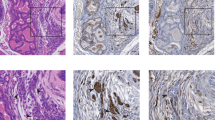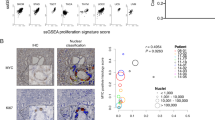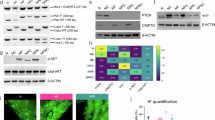Abstract
Chromosomal translocations involving the ERG locus are frequent events in human prostate cancer pathogenesis; however, the biological role of aberrant ERG expression is controversial1. Here we show that aberrant expression of ERG is a progression event in prostate tumorigenesis. We find that prostate cancer specimens containing the TMPRSS2-ERG rearrangement are significantly enriched for loss of the tumor suppressor PTEN. In concordance with these findings, transgenic overexpression of ERG in mouse prostate tissue promotes marked acceleration and progression of high-grade prostatic intraepithelial neoplasia (HGPIN) to prostatic adenocarcinoma in a Pten heterozygous background. In vitro overexpression of ERG promotes cell migration, a property necessary for tumorigenesis, without affecting proliferation. ADAMTS1 and CXCR4, two candidate genes strongly associated with cell migration, were upregulated in the presence of ERG overexpression. Thus, ERG has a distinct role in prostate cancer progression and cooperates with PTEN haploinsufficiency to promote progression of HGPIN to invasive adenocarcinoma.
This is a preview of subscription content, access via your institution
Access options
Subscribe to this journal
Receive 12 print issues and online access
$209.00 per year
only $17.42 per issue
Buy this article
- Purchase on SpringerLink
- Instant access to full article PDF
Prices may be subject to local taxes which are calculated during checkout




Similar content being viewed by others
Accession codes
References
Tomlins, S.A. et al. Recurrent fusion of TMPRSS2 and ETS transcription factor genes in prostate cancer. Science 310, 644–648 (2005).
Tu, J.J. et al. Gene fusions between TMPRSS2 and ETS family genes in prostate cancer: frequency and transcript variant analysis by RT-PCR and FISH on paraffin-embedded tissues. Mod. Pathol. 20, 921–928 (2007).
Perner, S. et al. TMPRSS2-ERG fusion prostate cancer: an early molecular event associated with invasion. Am. J. Surg. Pathol. 31, 882–888 (2007).
Hermans, K.G. et al. Two unique novel prostate-specific and androgen-regulated fusion partners of ETV4 in prostate cancer. Cancer Res. 68, 3094–3098 (2008).
Helgeson, B.E. et al. Characterization of TMPRSS2:ETV4 and SLC45A3:ETV5 gene fusions in prostate cancer. Cancer Res. 68, 73–80 (2008).
Tomlins, S.A. et al. Role of the TMPRSS2-ERG gene fusion in prostate cancer. Neoplasia 10, 177–188 (2008).
Tomlins, S.A. et al. Distinct classes of chromosomal rearrangements create oncogenic ETS gene fusions in prostate cancer. Nature 448, 595–601 (2007).
Mosquera, J.M. et al. Characterization of TMPRSS2-ERG fusion in high-grade prostatic intraepithelial neoplasia and potential clinical implications. Clin. Cancer Res. 14, 3380–3385 (2008).
Bettendorf, O. et al. Chromosomal imbalances, loss of heterozygousity, and immunohistochemical expression of TP53, RB1, and PTEN in intraductal cancer, intraepithelial neoplasia, and invasive adenocarcinoma of the prostate. Genes Chromosom. Cancer 47, 565–572 (2008).
Gray, I.C. et al. Mutation and expression analysis of the putative prostate tumour-suppressor gene PTEN. Br. J. Cancer 78, 1296–1300 (1998).
Whang, Y.E. et al. Inactivation of the tumor suppressor PTEN/MMAC1 in advanced human prostate cancer through loss of expression. Proc. Natl. Acad. Sci. USA 95, 5246–5250 (1998).
Di Cristofano, A., Pesce, B., Cordon-Cardo, C. & Pandolfi, P.P. Pten is essential for embryonic development and tumour suppression. Nat. Genet. 19, 348–355 (1998).
Trotman, L.C. et al. Pten dose dictates cancer progression in the prostate. PLoS Biol. 1, 385–396 (2003).
Chen, Z. et al. Crucial role of p53-dependent cellular senescence in suppression of Pten-deficient tumorigenesis. Nature 436, 725–730 (2005).
King, J.C. et al. Cooperativity of TMPRSS2-ERG with PI3-kinase pathway activation in prostate oncogenesis. Nat. Genet. advance online publication, doi:10.1038/ng.371 (26 April 2009).
Yoshimoto, M. et al. Absence of TMPRSS2:ERG fusions and PTEN losses in prostate cancer is associated with a favorable outcome. Mod. Pathol. 21, 1451–1460 (2008).
Arya, M., Ahmed, H., Silhi, N., Williamson, M. & Patel, H.R. Clinical importance and therapeutic implications of the pivotal CXCL12-CXCR4 (chemokine ligand-receptor) interaction in cancer cell migration. Tumour Biol. 28, 123–131 (2007).
Krampert, M. et al. ADAMTS1 proteinase is up-regulated in wounded skin and regulates migration of fibroblasts and endothelial cells. J. Biol. Chem. 280, 23844–23852 (2005).
Salvucci, O. et al. The role of CXCR4 receptor expression in breast cancer: a large tissue microarray study. Breast Cancer Res. Treat. 97, 275–283 (2006).
Ratajczak, M.Z. et al. The pleiotropic effects of the SDF-1-CXCR4 axis in organogenesis, regeneration and tumorigenesis. Leukemia 20, 1915–1924 (2006).
Arya, M. et al. The importance of the CXCL12-CXCR4 chemokine ligand-receptor interaction in prostate cancer metastasis. J. Exp. Ther. Oncol. 4, 291–303 (2004).
Hart, C.A., Brown, M., Bagley, S., Sharrard, M. & Clarke, N.W. Invasive characteristics of human prostatic epithelial cells: understanding the metastatic process. Br. J. Cancer 92, 503–512 (2005).
Maroni, P., Bendinelli, P., Matteucci, E. & Desiderio, M.A. HGF induces CXCR4 and CXCL12-mediated tumor invasion through Ets1 and NF-kappaB. Carcinogenesis 28, 267–279 (2007).
Xing, Y. et al. Tumor cell-specific blockade of CXCR4/SDF-1 interactions in prostate cancer cells by hTERT promoter induced CXCR4 knockdown. Cancer Biol. Ther. 7, 1840–1849 (2008).
Leversha, M.A. Mapping of genomic clones by fluorescence in situ hybridization. Methods Mol. Biol. 175, 109–127 (2001).
Strahl-Bolsinger, S., Hecht, A., Luo, K. & Grunstein, M. SIR2 and SIR4 interactions differ in core and extended telomeric heterochromatin in yeast. Genes Dev. 11, 83–93 (1997).
Acknowledgements
We are grateful to all members of the Pandolfi laboratory and C. Sawyers and his group for stimulating discussions regarding our study project. We thank P. Romanienko and W. Mark from our genetically engineered mouse core facility for their assistance in generating and genotyping our prostate-specific ERG mouse model. We also thank S. Hayward (Vanderbilt-Ingram Cancer Center) for providing us with the BPH-1 cells used for our experiments, R. Lester at our animal facility for caring for our mice on a daily basis and L. DiSantis for her editorial support. This work was funded through grants from the US National Institutes of Health (R01-CA82328, R01-CA84292, P50-CA92629) and Memorial Sloan Kettering Cancer Center Research in Therapeutics Program in Prostate Cancer award to B.S.C. and P.P.P.
Author information
Authors and Affiliations
Contributions
B.S.C. designed the study, conducted and supervised all experiments and wrote the manuscript along with P.P.P. J.T. conducted in vivo and in vitro experiments. A.G. designed and performed the human tissue analyses. Z.C. provided the prostate tissue from our Pten/Trp53 prostate conditional null series of mice. S.S. performed the BPH-1 cell experiments. A.C., A.A., C.N., S.V. and P.T.S. provided critical discussion on the generation of our mouse model and experimental design. C.C.-C. reviewed our mouse prostate histology. W.G. supervised A.G. on the human tissue studies and reviewed our mouse prostate histology. P.P.P. supervised and mentored all work. All authors approved of the final manuscript.
Corresponding author
Supplementary information
Supplementary Text and Figures
Supplementary Table 1, Supplementary Figures 1 and 2 (PDF 789 kb)
Rights and permissions
About this article
Cite this article
Carver, B., Tran, J., Gopalan, A. et al. Aberrant ERG expression cooperates with loss of PTEN to promote cancer progression in the prostate. Nat Genet 41, 619–624 (2009). https://doi.org/10.1038/ng.370
Received:
Accepted:
Published:
Issue Date:
DOI: https://doi.org/10.1038/ng.370



